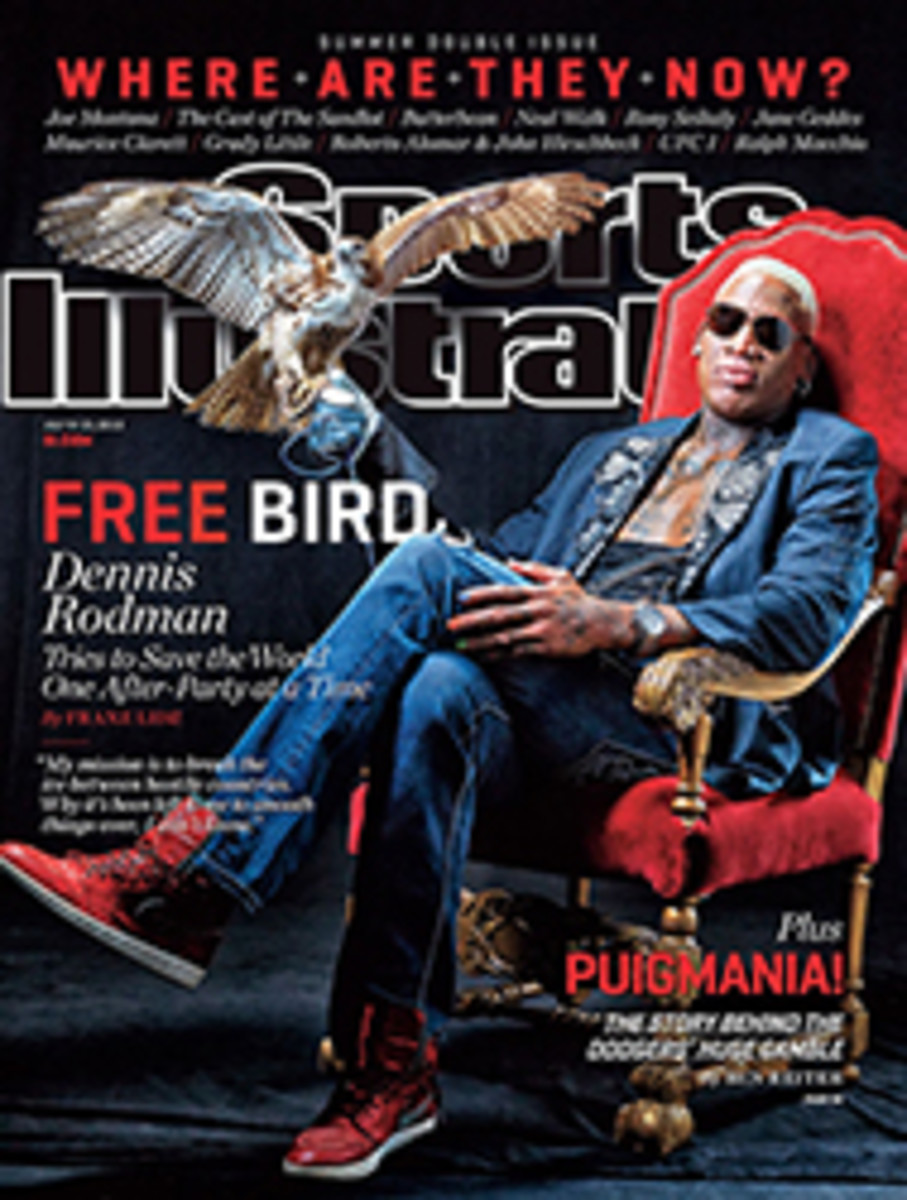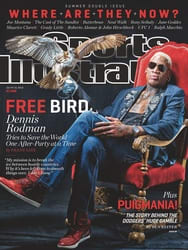
RONY SEIKALY
Marquee nightclub in New York City has consistently ranked among the world's highest-grossing such venues since it opened in 2003, and as a May Friday night turns into a May Saturday morning, the place is still going strong. Outside, on 10th Avenue, young women in little dresses and young men with little ponytails line up to plead with iPad-wielding bouncers. Inside, a lucky 900 or so throng four-deep around the bar or tip marked-up bottles of vodka and champagne into one another's glasses. That, and they dance, driven by a beat so loud they can feel it in their chests and inspired by the hired professionals who gyrate their pelvises and wear pointy sequined headdresses that make them look like glittering rabbits.
At around 2:30 a.m., the frenzy building, the night's final performer climbs the stage for a two-hour set that will include not a single discernible lyric. "The deejay's freakin' seven feet tall!" somebody shouts. He is, to be precise, 6'11". He is also Rony Seikaly, who played center for four NBA teams over 11 seasons.
Seikaly, the musician, describes himself as "a progressive type of guy," and his basketball résumé corroborates the claim. Born in Lebanon, he moved to Greece at nine, played four years at Syracuse and, in 1988, was the first player drafted by the expansion Heat. When he joined Miami as the ninth pick, there were only about 20 foreign-born players in the NBA. Last season there were close to 100.
In January 1992, two months after Magic Johnson announced he had HIV and was retiring from the NBA, there was an outcry from players who objected to Johnson's participating in the February All-Star Game, partly because they feared infection. Seikaly had watched his cousin Robby die from AIDS in '86 after a tainted blood transfusion, and so he was, in his words, "a little more astute about how you get it." More than that: "I wanted Magic to feel he was one of us. Just because he was infected didn't mean he wasn't a human being."
So roughly an hour before a Heat-Lakers game at L.A.'s Great Western Forum, Seikaly approached Johnson—who was shooting to keep in shape—and challenged him to a game of one-on-one. "I'm not going to back down," Seikaly told him. "I'm not going to take it easy on you." The pair played for 30 full-throttle minutes as fans and teammates watched, and a month later a grateful Johnson was named the All-Star Game's MVP.
Seikaly's musical tastes were similarly ahead of their time. As a 14-year-old in Athens, he was unable to get into the clubs that played the dance music that he craved—he was deeply influenced early on by disco acts such as Barry White and Chic—so he installed himself as a deejay in his parents' garage. There he charged a $5 entry fee to friends and to the opposing players who came to town to face his school, ACS Athens. With the revenue from these 25- to 30-person shows he continually upgraded the lights and, more important, the sound system in what he came to call Disco 17, named after his street address.
By the time Seikaly reached the NBA, he had moved on to house music, which originated in underground clubs in Chicago and was ascending in Europe. But hip-hop still reigned in the U.S., particularly in the league's locker rooms. Seikaly recalls teammates tilting their heads at the thumps emanating from his car. Oh, Seik, you're still listening to this bull----?
Now, two decades later, house music has firmly entered the American mainstream, with acts such as Daft Punk and David Guetta having released wildly successful albums. Seikaly, who began producing his own tracks professionally about three years ago (his first album, House Calls, dropped in 2010), has seen demand for his services grow in tandem. Though his style skews less commercial than some other house artists'—he describes his as a "deeper sound," more concerned with moods than with hooks—he performs six to eight times per month all over the world, often in Miami, where he lives. In '09, he played a 2½-hour set for 5,000 revelers in Ibiza. "He is one of a kind," says the bald-headed, big-collared Noah Tepperberg, a cofounder of Marquee New York and one of the reasons Seikaly is here tonight.
Joining Seikaly on stage is Martha Graeff, the 27-year-old Brazilian model turned fashion blogger to whom he became engaged last summer on the Greek island of Mykonos. Waving her arms between sips of Red Bull, Graeff wears pants with vertical black and white stripes, and the stripes are very long indeed. Seikaly, meanwhile, sports a short-sleeved Henley open at the neck, beaded bracelets around his left wrist and modest black headphones. As he leans over a glowing console, he searches for the perfect blend of sounds to propel the night onward. Being tall, he says, can be a disadvantage in this particular profession, as decks tend to be set up low, and "you're always going home with a backache."
But that is a concern for later. Tonight is Seikaly's 48th birthday, and as the crowd chants Ro-NEE! Ro-NEE! a large cake appears to levitate from the back of the room toward the stage, earning a raised fist in acknowledgment from the deejay.
When he first started performing at clubs, Seikaly would deny that he was that Rony Seikaly, the former NBA star, and now he feels as if he has become established among an entirely new set of fans. "Here is my synopsis," he says. "Anybody who's 35 or over remembers me as Rony the basketball player. Anybody who's under 35 knows me as Rony the deejay and music producer."
"We don't know anything," say two dancing women when asked about the music maker's identity. "We are Dutch!"
If he were playing in the NBA today, Seikaly believes he would be more productive than he was back when he was nicknamed the Spin Doctor, for his twirling post moves. "In the old days," he says, "you'd have to go up against a beast every night—a 7'2", 275-pound guy who is in the box and not moving from that box. Now everybody's just floating around. It would be so much easier to post up against these guys and take them to the hole. Dwight Howard is the only guy that is kind of a cross between my years and this generation."
These days, though, Seikaly is mostly concerned with the realities of the present. "In basketball I was always looking ahead, and when it was all over with I was like, Wait a minute, that was fast," he says. "With [deejaying], I'm taking it in every day, every song, just enjoying the moment. It's all about the music. I don't care about people who aren't in the club to listen—they're there to pick up chicks, do other things. I love playing for people who love to listen, and that's really it. I don't know how long I'm going to do this for. I'm going to do it until I don't enjoy it anymore."
As 4:30 a.m. approaches and Seikaly's set ends, Marquee's house lights flicker on to reveal sweaty faces smeared with makeup. "To keep people on the dance floor, it's really something," says Seikaly, perspiring and slightly breathless. "They feel you and you feel them—that's when the party is really good."
With Martha at his side, Seikaly cuts through a crowd of well-wishers, makes a practiced duck of his head through a door frame and emerges into the Manhattan night. A thickly accented Muscovite with more hair on his chest than on his head trails him and asks, "When are you going to Russia?"
"I don't know," Seikaly replies good-naturedly. "Soon, hopefully."
"Let's do it."
As Seikaly strides up 10th Avenue, beneath his name on Marquee's marquee and toward a black town car into which he'll have to fold himself, the stranger lobs one more question. "Where you headed to next, Rony?"
"Next? To bed."
Seikaly recalls teammates tilting their heads at the thumps emanating from his car. Oh, Seik, you're still listening to this bull----?
NOTEBOOK
Five Completely Trivial Things We Learned About Rony Seikaly
1
From 1999 to 2005, Seikaly was married to model Elsa Benitez, who graced the cover of SPORTS ILLUSTRATED'S 2001 and '06 Swimsuit Issues. Their daughter, Mila, is 10.
2
Music is actually Seikaly's third career. He is also a real estate investor and developer in Miami, a pursuit that he considers his full-time job.
3
Over 11 seasons with the Heat, Warriors, Magic and Nets, Seikaly went 268--410 and never advanced in the playoffs. "That is sometimes how the cookie crumbles when you are a good college player," he says. "You end up going to the worst teams."
4
His favorite teammates: guards Brian Shaw, newly named head coach of the Nuggets, and Steve Smith, an NBA TV studio analyst. "As a European player back then, it was very hard for people to get me," says Seikaly. "Those guys got that my culture is different, I'm from a different place on this Earth."
5
His least favorite player to guard: Rockets Hall of Fame center Hakeem Olajuwon. "He was so unpredictable," says Seikaly. "They called him the Dream, but for me he was a nightmare."
TABLET EXTRA
Sample Seikaly's sounds—"Thanks for Everything" and "You Make Me Feel"— by downloading the digital edition, available free to subscribers at SI.com/activate
PHOTO
Photograph by SUZY ALLMAN FOR SPORTS ILLUSTRATED
SEIK-O KILLER Before he joined the Heat, Seikaly's sweet moves helped Syracuse slay North Carolina at the 1987 NCAA tournament, where the Orange came a point short against Indiana in the title game.
PHOTO
MANNY MILLAN/SPORTS ILLUSTRATED
[See caption above]
PHOTO
SUZY ALLMAN FOR SPORTS ILLUSTRATED
IN THE HEAT OF THE NIGHT Seikaly's new career has him playing in New York (above), Ibiza and in his adopted home of Miami, the city for which he once went toe-to-toe with Hakeem Olajuwon.
PHOTO
JOHN BIEVER FOR SPORTS ILLUSTRATED
[See caption above]
ILLUSTRATION

